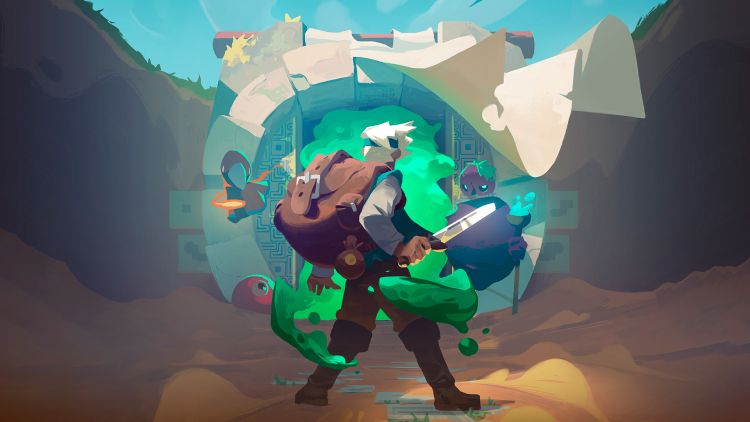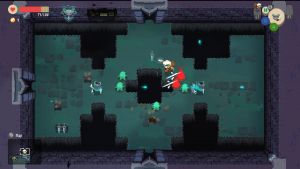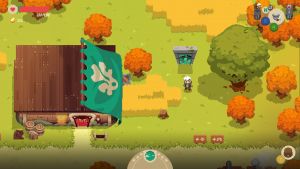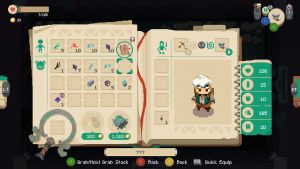From time to time, adventure games are criticized for disregarding the aftermath of their stories. They only focus on the action, then wrap it up with the happy ending. For the people that have always craved the ability to see what comes after the thrilling dungeon crawl, Moonlighter has good news: Now you can.
Game Name: Moonlighter
Platform(s): PC (reviewed), also on PS4 and Xbox One
Publisher(s): 11 Bit Studios
Developer(s): Digital Sun Games
Release Date: May 29, 2018
Price: $19.99
Moonlighter follows the story of a protagonist named Will, as well as the story of his town, Rynoka. Rynoka sits on the outskirts of a series of dungeon gates, waiting to welcome any brave adventurer inside. At one time, the city’s best would venture in and return victorious, bringing back artifacts the world had never before seen. Rynoka prospered, and its people were happy. Then one day, those adventurers stopped coming back, and despite valiant attempts to move on, the city never truly recovered from the loss.
Will’s family was once a part of the artifact trade, and has inherited his family’s shop, Moonlighter. He could be happy like this, working day in and day out, selling various items he can scrounge up, but he wants more. Giving little heed to the warnings he was given, he sets off on his own adventure to conquer these dungeons, and brings back bigger and better artifacts to sell at his shop.
In order to talk about Moonlighter, we need to discuss two different sections of the game: the adventuring part, and the shopkeeping part. These two halves are both important, and they work together to make the game fun, but their mechanics are very different, and it would be unfair to judge one by the other’s standards.
Adventuring
Moonlighter throws you into the action instantly. Upon opening the game, you find yourself in a dungeon filled with monsters you don’t know. In this way, you learn the mechanics of the game, running, jumping, and striking your way to victory.
And then you lose.
One of the greatest parts about Moonlighter’s dungeoneering is that “losing” isn’t always a bad thing: It’s a concept they introduce in the beginning sequence, and it ties in later on in smaller ways. Will enters a new room of the tutorial dungeon, is completely overwhelmed with enemies, and finds that none of his previous instruction in running, jumping and striking will save him. He dies, and then finds himself outside the dungeon altogether to continue the tutorial.
Becoming familiar with your own limitations as an adventurer is critical to enjoying the game, because you will encounter enemies and circumstances you aren’t yet ready to face. The key word there is “yet.” As you advance in the game, you’ll come upon upgrades that will help you become better and stronger, but that kind of advancement takes time and patience. In the moment, though, when you realize you aren’t ready, the game reminds you to make use of your last line of defense: an amulet that teleports you back to town. In town, you can sell your wares, use your money to buy new and better tools, rinse, and repeat.
This process can be frustrating, but another wonderful part about Moonlighter is that it’s bite-sized. If you find yourself too frustrated to hit a dungeon one more time, you don’t have to. You can just… stop. You can put down the game, and come back to it later, whether that “later” is later that day, or later that week. The game’s format allows you to do this without missing anything, and it autosaves frequently.
Shopkeeping
The shop, on the other hand, is a completely different monster. No amount of running and jumping will save you here. This arena demands a fundamental understanding of supply and demand, and how to leverage it to your advantage. This aspect of the game also has a brief tutorial, where Zenon, a wizardy NPC, instructs you in the ways of economic magic.
Selling an item for a price too low means that you’re missing opportunities. Selling an item for a price too high means it won’t be bought – or, if it is, it will make your customers very unhappy. It’s a delicate balance, and it’s up to you to find the sweet spot for your items… individually.
The learning curve is a little bit steep, because you go into this commercial dungeon with no bearings whatsoever on the value of an item. It’s easy enough to figure that roots won’t be very valuable, but what about steel? What about an ornately-decorated vase? Your only touchstone is that the power crystals, a relatively rare item, are best sold for 100 gold. That’s all you get. You have to figure the rest out on your own.
Thankfully, trial and error is your friend. The game is equipped with a journal function, which chronicles past reactions to items in a simple, at-a-glance format, so you can remember which prices worked and which didn’t. Additionally, if you’ve sold an item before, when you place it on the table you will automatically see the last price you entered. This is especially handy for selling a hell of a lot of vines and roots.
When you’re working in your shop, you aren’t trapped behind the counter. This means that part of running the shop is frantically running to your display table to restock items, then running back to the counter to finalize sales. If you run out, you can easily duck into your back room, grab things out of your trunk, and dash back to the front. This makes gameplay more involved than your average shop simulator, where for some amount of time, you’re restricted to simply watching your mistakes unfold over time.
And of course, what would a shopkeeping adventure game be without a crafting system? Moonlighter‘s crafting takes the form of migratory craftspeople, who come to your town upon your request. They can make items for your use, sure, but they can also make items for you to sell. On the surface, the system doesn’t appear to be anything remarkable, but there are several key features that put Moonlighter‘s crafting a cut above the rest.
For starters, the game implements a “wishlist” function. This means that if you know you want to craft a certain item, you can add it to your wishlist. When you collect resources, items that are part of that crafting recipe now have a sticker attached to them, to indicate their importance. Also, to craft an item, you don’t need to have it in your inventory. If you forgot to pick up steel from your storage before you went to the blacksmith, not to worry: you can craft the item anyway, and the system will take it from your storage. Hassle-free, easy, simple. Finally, the crafting gods have shown us mercy.
Overall
The visuals of the game are nothing short of astounding. Moonlighter‘s pixel graphics hearken back to classic adventure games, but they don’t sacrifice the quality of the modern ones. Digital Sun found a way to make water, goop, and slime feel like they really should. Fabric flaps in the wind, grass and hair sways with movement, and long grass parts around the player’s body as they walk through it. Every texture has a place here, and nothing is skimped.
The color schemes, in general, are beautiful. Rynoka’s landscapes are full of natural light and colors, with gentle browns and greens everywhere. In the nighttime, fireflies gather in the fields, and streetlamps glow softly with flickering firelight. Inside dungeons, spooky enemies are colored unnaturally brightly, and ancient guardians wear rusty shells, indicative of just how long they’ve been around.
The music is phenomonal. If ever a soundtrack exemplified “adventure,” this is it. I loved listening to the transition between areas, and playing along to the expertly-crafted sound design. Sound effects are simple, and don’t get in the way of enjoying the music, nor does the music overshadow the sounds.
Movement feels good. When Will gets out of bed, when he walks around, when he rolls, he moves fluidly. His attacks are simple because they don’t need to be complex. The complexity is in the environments, the opponents, and the ever-changing tide of economic transactions. Moonlighter has stuck a perfect balance in nearly every aspect.
My one complaint about the game is a simple one: Because many of the game’s indicators aren’t labeled, some indicators aren’t obvious. I’m speaking specifically about one occassion where I was in the first dungeon, wiping out enemies, when a circle appeared in the bottom left with a moving eye and a clock symbol. Having never encountered this before, I was bewildered. In the five seconds it took for me to think about what this might be, a dungeon boss spawned in the room, and I realized what it was: a warning indicator for that specific creature. It’s the kind of mistake you only make once, and I’ll certainly remember it, but it definitely surprised me.
Moonlighter is available on PC, GOG, Steam, Humble, Xbox One, and PS4. For more information, visit their website, here.
Summary
A vibrant, fresh blend of rogue-like and store management games, with something for everyone. Aesthetically beautiful, narratively rich, extremely satisfying to play.








